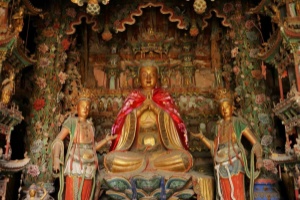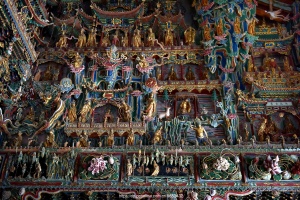Xiaoxitian, also known as Qianfoan(千佛庵), is a Buddhist Zen monastery founded by the monk Dongming in the second year of the Chongzhen reign of the Ming Dynasty (1629). It was originally named for the thousand Buddha statues housed in the Main Hall of Great Buddha. Later, due to the inscription “Entering the Xiaoxitian” on the gate and the need to distinguish it from another Ming Dynasty monastery called “Daxitian” to the south of the city, it was renamed “Xiaoxitian.”
The architectural style and characteristics of Xiaoxitian can be summarized in four words: "small, delicate, exquisite, and unique." The entire monastery covers an area of over 1,100 square meters and includes many halls and chambers such as the Main Hall of Great Buddha, the Wenshu Hall, the Puxian Hall, the Hall without Beams, the Tianwang Hall, the Weituo Hall, the Dizang Hall, the Bell Tower, and the Drum Tower. These structures are stacked and intertwined, creating a maze of paths that lead to secluded corners. It embodies the layout of a typical monastery while also exhibiting the charm of garden architecture. Two-thirds of the monastery's halls feature double-story structures, displaying intricate designs and unique characteristics.


Moreover, Xiaoxitian is renowned for its "suspended sculptures." These sculptures are colorful and diverse in form, with lifelike figures and numerous intricate details. The painted decorations in the beams of the Main Hall of Great Buddha are valuable, resembling the dragon and phoenix paintings of the imperial palace, which belong to the highest grade of Ming and Qing architectural paintings. They demonstrate the superb skills and profound cultural heritage of ancient artists. These suspended sculptures and painted decorations not only possess exceptional artistic value but also serve as witnesses to the Buddhist culture of the Ming Dynasty, reflecting ancient social life, religious beliefs, and artistic aesthetics.
In addition, Xiaoxitian carries rich historical and cultural significance and is a place of faith for residents. During Buddhist festivals every year, grand Dharma assemblies are held here, attracting believers from all directions to participate, enriching the local cultural life, and promoting the inheritance and development of Buddhist culture. Shanxi Xiaoxitian is a Buddhist monastery full of artistic charm and historical significance. Whether it's its architectural style, suspended sculpture art, or its profound historical and cultural connotation, it has become a worth-visiting destination.
Travel Information
Opening hours
Open all year 07:30-18:00, 7:30-18:00 in winter, 7:30-18:30 in spring, summer and autumn.
Telephone
0357-6733033




































